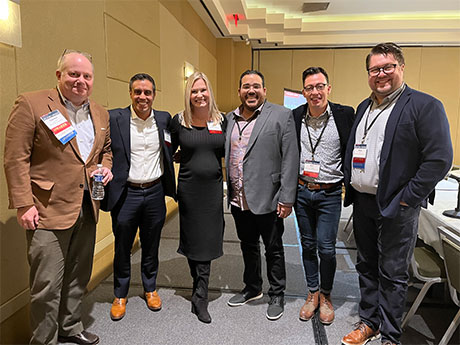ATLANTA — This year has been a tumultuous one for multifamily construction. Between rising interest rates, fluctuating supply lines, costs of materials and difficulties procuring labor, developer confidence in new multifamily starts is faltering as work on current projects is beginning to slow.
“In this market, it’s so hard to stay abreast of all of the changes that are happening,” said Cara Frost, director of preconstruction at Juneau Construction, which is based in Atlanta. “And that has led to a more design-assist approach on our end.”
Frost’s comment came during the “What to Look for in Architecture, Design and Construction Trends in 2023” panel at the 13th annual InterFace Multifamily Southeast on Dec. 1. France Media hosted the event at the Westin Buckhead hotel in Atlanta. There were approximately 325 conference attendees.
Joe Martinez, president of Atlanta-based real estate development and investment firm Vida Cos., moderated the panel. Speakers discussed the challenges they are currently facing and emphasized the importance of collaboration and transparency early in the process of a project.
“There are three buckets — budget, time and quality — and right now, you get to be really good at two of those things,” remarked Josh Kassing, vice president of design development at Chicago-based Mary Cook Associates. “So, we pick the two that are the focus and try to come to an understanding on how we can best navigate that third one.
“At the end of the day, it’s about developing a product that’s focused on who lives there and what it’s trying to do for the market, not about what it looks like.”
High-rise development is slowing down, and that is emblematic of the state of the industry going into 2023, particularly due to the size of the project and the costs and labor typically associated with such projects.
“Right now, value engineering just isn’t working,” explained Cannon Reynolds, managing director at Niles Bolton Associates. “You put the projects on hold, you re-price and think you’ve just cut $1 or $2 million, but the price went up. The old playbook of how we get things under control is not working anymore.”
“We need a more collaborative approach,” concluded Reynolds. “Tell us what the goal is and let us figure out how to do it. Let’s work together to figure out how to how to add value.”
Reynolds’ sentiment was echoed by his fellow panelists, including Brad Lutz, managing principal and Chicago residential practice leader of Baker Barrios Architects.
“In those early stages, it’s important to make sure everyone is on the same page,” said Lutz. “Is this a long-term hold? Are we trying to flip this before it’s done? What is the construction type we’re going to pursue? The design comes along a lot more easily when those crucial conversations are had early on, with feedback from as many people as possible.”
Cristian Oquendo, president and principal at Charlan Brock Architects, also shared the sentiment that collaboration is an important aspect of the development process, but additionally emphasized the importance of transparency between those involved in a project.
“For years, developers have been reluctant to share things like construction budgets and costs, but it’s better for us to design with a budget in mind,” he explained. “And we’re seeing that more and more these days. Everyone’s already seen the numbers already, which has been very positive for the process.”
Frost noted that “building trust” and guaranteeing everyone a spot at the table to have input in design and planning early on has been helpful to the completion of projects at Juneau Construction. However, she additionally noted an interesting trend when it came to high-rises.
“In the last four months, we’ve seen a substantial increase in a mix of high-rise designs with a wood frame wrap attached to it.,” she said. The wrap concept generally involves a central above-ground structure that is surrounded by multiple stories of wood construction. This allows developers to maximize density and make the best use of economical materials.
“The high-rise is expensive, but you can offset that cost and make the best use out of the limited land you have,” Frost concluded. “There’s something to that in multi-unit construction. People are working together to find creative solutions.”
— Channing Hamilton


